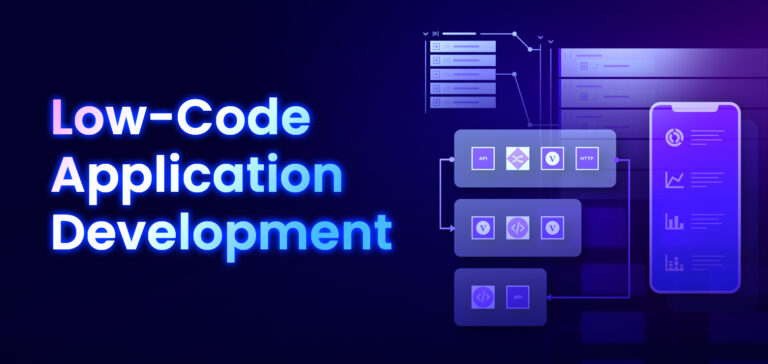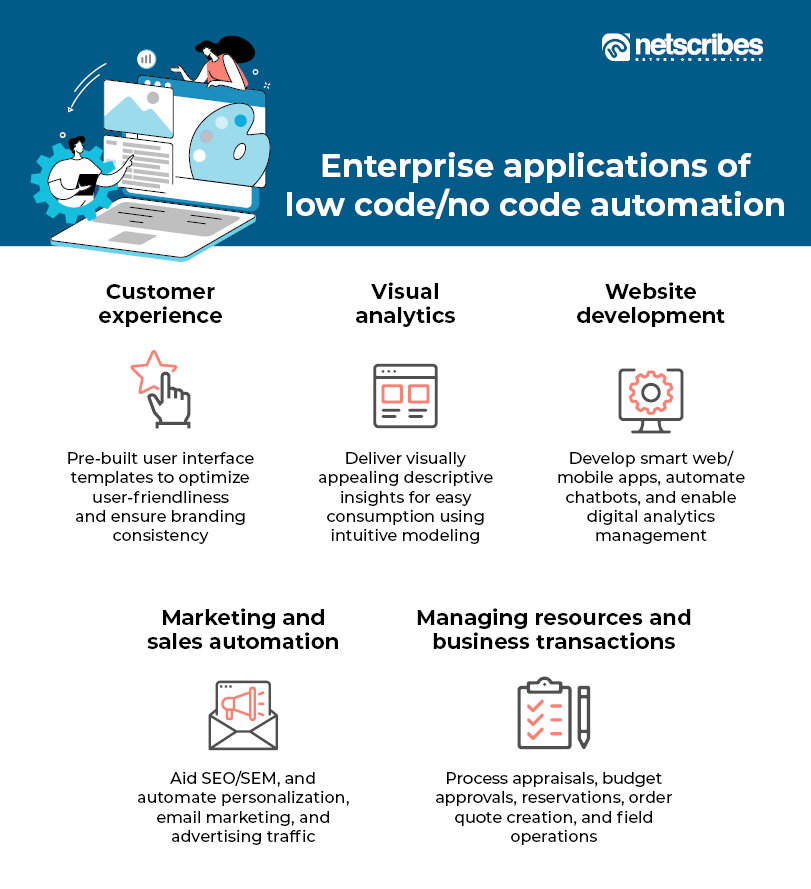Recommended Reasons To Picking Legacy application modernization with Low-code
Wiki Article
The Benefits Of Low-Code Programming For Application Development In Relation To Relates To Integration Capabilities
Low-code development of applications offers huge advantages in terms of integration capabilities, which are essential for creating applications that seamlessly connect with diverse systems and services. Here are the benefits of pre-built APIs and connectors:
An extensive range of connectors. Low-code systems usually include an array of pre-built connections to the enterprise system that are widely used (e.g. cloud-based services, databases and CRM). The process of integrating the systems can be made simpler.
API Integration: Many low-code platforms come with API integration options, which allow developers to connect to other services and data sources with ease.
Usability:
Drag-and-Drop Interfaces: A variety of integration tasks can be easily completed using drag-and–drop interfaces. This makes it feasible for developers and other non-developers to build complex systems without the need for extensive programming.
Visual Workflow Creators: The visual tools that are used to design workflows and data flows make it easier for users to comprehend the integration process.
Standardized Integration Methods:
SOAP/RESTful Service Support: Standard web service protocols, such as SOAP/REST, facilitate the integration of a variety of external systems and applications.
OData Standards: OData standards allow for easy manipulation and access of data across a variety of platforms and apps.
Real-Time Data Synchronization:
Real-Time Integrations: Lowcode platforms can handle data synchronization at a real-time rate between applications and system making sure that data is current and consistent across an company.
Event-Driven Architectures: Certain platforms provide event-driven architectures that allow applications to respond in real-time when events occur, which is crucial for dynamic applications.
Legacy System Integration:
Low-code Platforms: These platforms can be utilized to connect older systems to the latest. They're a great option to upgrade your IT infrastructure without the need to completely overhaul your IT infrastructure.
Data Migration Tools - Built-in data migration tools make it easy to transfer data from older systems to low-code applications.
Third-Party Integration of Services:
Cloud Services Integration: Easy scaling and deployment of apps is possible with seamless integration of cloud services like AWS, Azure and Google Cloud.
Business Applications Integration : Low-code platform can integrate with diverse business applications, such as Salesforce.com, SAP, Microsoft Dynamics and others to provide a seamless workflow that spans various business functions.
Simplified Data Management:
Unified Data Models: Certain lowcode platforms offer common coding models, which make it easier to manage managing data, integration and synchronization across various systems.
Data Connectors are data connectors that have been pre-configured which provide rapid access to data sources and allow manipulation.
Security and Compliance
Low-code integration platforms adhere to security standards to safeguard the data during transport or in rest.
Compliance Features: These platforms typically have features to ensure that integrations comply with the requirements of regulatory agencies (e.g., GDPR, HIPAA), providing peace of mind for businesses that handle sensitive information.
Extensibility:
Low-code platforms are able to accommodate complex integration needs by including custom code or scripts. They allow for flexibility without compromising their user-friendliness.
Plug-in Ecosystems. An ecosystem of extensions and plug-ins allows you to further enhance the capabilities of integration, while adding new functionalities whenever needed.
In general, low-code development platforms offer strong integration capabilities, making them a great instrument for creating functional and interconnected applications. They are able to streamline the process of connecting disparate systems, and increase the flow of data. Companies can leverage existing technologies and develop new ones, while ensuring a seamless IT environment. Follow the most popular Low-code Platform for application development advice for site info including application modernisation, cross platform mobile development, app dev platform, application development platforms, application development platforms, rapid application design, build with docker, application modernization software, cloud software applications, jdbc server and more.

Scalability And Flexibility Are Two Advantages Of Low-Code Application Development
Low-code application creation offers several advantages, particularly in terms of scalability. This is important to build applications that will develop with your business and adapt to evolves. These are the most significant benefits:
Cloud-Based Deployment. Many low-code platforms have a cloud-based deployment that allows users to easily scale their applications by using cloud infrastructure. This allows companies to handle increased workloads without having to worry about managing servers.
Auto-Scaling Features: Built-in auto-scaling features can automatically adjust resources in response to the demand, ensuring a consistent performance during peak times without the need for manual intervention.
Flexible Architecture:
Modular Application Design: The low-code platform allows for modular design of application. Components can be independently evaluated, designed and increased in size. Modularity improves flexibility and it is easier to modify specific elements of an app without having to affect the entire system.
Microservices integration: The ability to support microservices architecture allows applications to be built as a collection of loosely coupled services. This improves scalability, and flexibility.
Customizable Solutions
Extensibility: Low-code platforms typically permit custom programming and scripting, enabling developers to extend the functionality of the application beyond what is already available. Developers can meet their own business needs without restrictions.
Third-Party Integrations: Integration with third-party APIs or services allows businesses to add additional functionality to their software.
Agile Development and deployment
Continuous Delivery and Deployment Low-code Platforms facilitate agile methods by enabling continuous Integration and Continuous Delivery (CI/CD). This allows for rapid deployment and update of new features.
Iterative Design: Because low-code is an iterative procedure, applications can be gradually improved and enlarged. This permits controlled growth and reduces the risks associated with large-scale modifications.
Resource Optimization
Effective Resource Management: Low Code platforms can maximize resource utilization by using tools that monitor and control the performance of applications. This ensures that resources are being used efficiently. They can also be scaled up or down according to actual needs.
Load Balancing: Integrated load balancing capabilities distribute the burden evenly across servers, enhancing the capacity of applications to handle large volumes of traffic while ensure consistency in performance.
Global Reach
Multi-Region deployment: Low-code applications typically allow deployment in multiple geographical regions. This allows companies to offer low-latency to users across the globe. This is essential, especially when it comes to applications that have global users.
Localization Support for localization integrated into the software, allowing applications to be easily modified to accommodate different languages or regional requirements. This enhances flexibility for different markets.
Maintenance and updates
Low-code applications are visually and are modularly built, which simplifies maintenance. Updates or bug fixes can be completed quickly and without lengthy downtime.
Version Control: Integrated version control software helps manage changes and rolls backs. This ensures that updates can easily be deployed and previous versions restored if required.
Cost Efficiency:
Lower development costs: By reducing the need for a lot of coding, low-code platforms lower development costs and allow to scale applications without substantial increase in expenditure and effort.
Pay-As-You Go Models - Many low-code platforms have flexible pricing models such as pay-as-you go that adjusts prices to the actual usage, growth, as well as financial flexibility.
Low-code development provides businesses with many advantages, including scalability flexibility and adaptability. This allows them to develop robust, flexible and scalable applications. These platforms permit quick adaption to changing needs as well as efficient utilization of resources and continual improvement. This means that the applications are able to grow along with the company. Take a look at the best Legacy application modernization with Low-code for site info including develop cross platform mobile app, app modernization, low code platforms, software for app development, application modernisation, jdbc server, cross platform mobile development, azure sql, cross platform mobile app development, database in azure and more.

Regarding Support From Vendors And Community Involvement, Low-Code Development Has Many Advantages.
Low-code development platforms have distinct advantages in terms of vendor support and the community. These are crucial for successful implementations, ongoing maintenance, as well as continuous development. Here are the major advantages: Support from vendors
Comprehensive Technical Support:
A Support Team Dedicated: Most low code platforms have dedicated support personnel who are available to help with technical questions, troubleshooting issues and providing advice. They can make sure that problems are solved quickly.
24/7 Support Some suppliers are available 24/7 and this is helpful for businesses operating in multiple time zones.
Training and Onboarding
Training programs that are structured: Vendors provide structured courses such as webinars or certification courses. This helps users quickly grasp the platform.
Personalized Onboarding: A lot of vendors provide customized onboarding services that help new customers to use the platform efficiently and adapt it to their specific requirements.
Regular updates and enhancements
Continuous Improvement: Low code platform providers release regular updates, which include new security patches, features and performance enhancements. This helps ensure that the platform is always current and secure.
Feedback Integration: Vendors integrate feedback from users into their development cycles to ensure that the platform is continually evolving to meet the changing requirements of their users.
Comprehensive Documentation:
Documentation - Detailed Documentation: A complete and well-organized documentation that covers everything from basic usage to advanced customizations, is often available. This lets users solve issues on their own.
API References Detailed API documentation lets developers modify applications and connect low-code platforms with other platforms.
Consultancy and Professional Services
Expert Consulting: Vendors often provide consulting services that assist in the process of strategic planning, architecture design, and complex implementations, ensuring that users can leverage the platform to its fullest potential.
Custom Development Services - Some vendors provide customized development services for specific capabilities or integrations that are not offered from the standard version.
Community Support for the Community
Active User Communities:
Forums and Discussion Panels: A lot of Low-code platforms offer lively online communities which allow users to ask questions, debate solutions, and collaborate on best methods.
Local and Virtual User Groups and Meetups, provide opportunities for users to share their experiences, gain knowledge from other users, and connect with.
Knowledge Sharing and Collaboration
Community-Contributed Resources: Users often share templates, modules, and extensions that they have developed, which can be reused or adapted by others, accelerating development and innovation.
Crowdsourced Problem-Solving: The collective experience and knowledge of a community can be a valuable source to solve problems and discover creative solutions to complicated problems.
Learning and Development
Community-Led Training: Many communities host training sessions, workshops, and webinars. These are usually run by knowledgeable users who provide practical insights as well as advanced techniques.
Tutorials and online courses Community members frequently create and share online courses, tutorials, and guides on how-to, improving the learning resources for all users.
Feedback and Influence
Product Feedback Channels Community forums include many channels to provide feedback to vendors, which can influence the design of new features.
Beta Testing Programmes Participants in the Community who are active may be able to participate in beta-testing programs. This gives them an early glimpse of the latest features, as well as an opportunity to contribute to the evolution of the platform.
Recognition and Assistance:
Community Recognition Programs - Many vendors have recognition programs that acknowledge the contribution of the active members of their community, including MVP (Most Valuable Professionals) programs.
Peer Support. Community members provide assistance to each other. They offer their knowledge with less experienced users and offer advice. This creates a community that is supportive and collaborative.
In the end, the combination of of strong support from the vendor with a vibrant and engaged community creates an extensive support ecosystem for low code application development. The combination of strong vendor support and a vibrant and engaged community creates an extensive support system for low-code development.
